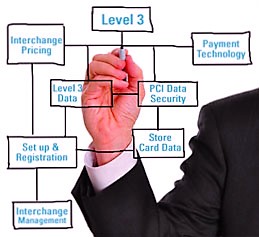An increasing number of Business to Government (B2G) and Business to Business (B2B) purchases are currently being made via business, corporate and purchasing credit cards. Traditionally speaking, these cards have some of the highest interchange rates in the world. In an effort to stimulate the American economy, a new program was initiated over the past several years. This particular program has already been taken advantage of by large government agencies and corporations to lower their merchant account fees. Find out more about using the Level 3 gateway to process your B2G and B2B transactions.
Streamlining the process of entering line item details on transactions
Consumer credit card transactions and corporate purchase card transactions are two different entities and they are priced differently. Some companies may want to get the best possible rate for their corporate purchases, which means additional line item detail are required on each transaction. As a significant amount of additional data is required, it is pertinent for merchants to accept such transactions with a Level 3 Processing System, as well as integrating payment acceptance into their existing ERP System. This will help eliminate manual entry of additional line item detail.
If you plan to implement a Level 3 payment gateway, be sure to check that it offers PCI-compliant solutions that feature tokenization, P2PE (Point-to-Point Encryption), as well as having the ability to eliminate card data that would otherwise be stored on a local server. Also you should walk yourself through a PCI Compliance Self-Assessment Questionnaire (a provider may do that for you) to avoid paying non-PCI compliance fees every month.
How do merchants qualify for Level 3 Credit Card Processing?
The rules of Level 3 processing state that merchants have to capture specific line item data in their credit card transactions. These additional data fields include tax amount, invoice number, merchant name and address as well as line item details such as product codes, commodity codes, freight amount and more. This extra reporting not only qualifies merchants for Level 3 credit card processing but also makes it easy for government and corporate to track and monitor internal spending.
Level 3 versus Level 1
To help you understand better about the distinct difference between Level 1 and Level 3 (or Level III) transactions, the former is often associated with B2C transactions and provides only limited purchase data back to the cardholder. The latter contains additional information that is found on itemized invoices, which is why it is highly recommended for B2B and B2G transactions. If you wish to improve your profit margins without being heavily taxed, the latter is what you should go for.
Benefits of processing Level 3 transactions
Merchants who choose to process Level 3 transactions can stand to save more money, as the interchange rates are significantly lower than Level 1 or Level 2 purchases. Also, merchants can easily receive detailed reporting to track their transactions seamlessly from beginning to settlement. What’s more, the reports can be tailored with up to sixty unique data points. Lastly, B2B companies get to enjoy huge savings because Level 3 transactions typically cost 0.50% to 1.50% less than standard Level 1 transactions.
